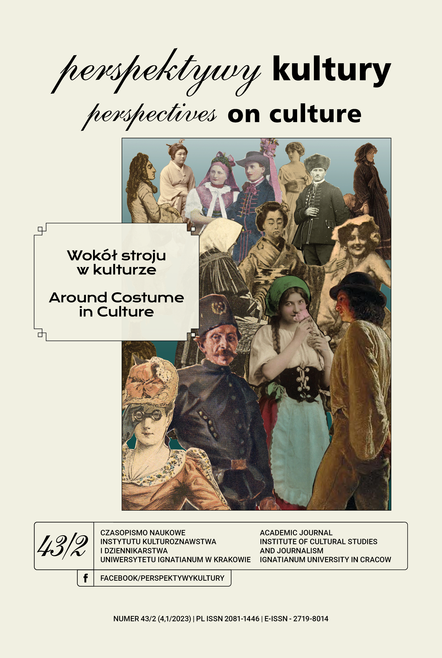Watch Chain as a Testimony of Human Emotions Hidden in a Beautiful Object – Short Case Studies
Abstract
The article deals with the issue of an original type of jewelry, i.e. watch chains, which in the past were an extraordinary testimony of human emotions expressed in them through symbols and signs presented in an exquisite artistic form. The basis for the considerations was the analysis of selected samples of antique watch chains from museum collections and studies on the history of jewelry, in particular “speaking” jewelry and its symbolism. Taking into account the fact that the subject has not yet been thoroughly researched, so that there is no study in the Polish scientific literature, and that the research in the field of functions, typology, material science, ornamentation and cultural and social significance of this forgotten type of jewelry is just beginning, the article is an attempt to set the directions of research in the field of symbolic meanings and emotional relations of these objects with their owners. In the course of the analysis of selected examples, an attempt has been made to identify and list the dominant patterns of love symbols characteristic of specific cultural circles, as well as to determine the ways of their formation and development in visual realizations in artistic craftsmanship. In addition to the decorative patterns of watch chains, in which the symbolism of feelings takes the form of a visual sign, the materials from which the objects were selected, for example the hair of a loved one, were also analyzed in terms of their emotional potential. The analyses showed that watch chains, in the role of a souvenir or a secret gift, were carriers of hidden messages about implicit or, on the contrary, manifested feelings in social groups, using specific cultural codes.
References
Ahde-Deal, P. (2013). Women and Jewelry. Helsinki: Aalto University publication series.
Banach, A. (1960). Podróże po szufladzie. Kraków: Wydawnictwo Literackie.
Bandura, A. (2017). Trichofilia – fetyszyzacja włosów w sztuce współczesnej w ujęciu estetycznym. Nowa krytyka, nr 39, 189-190.
Barański, J. (2008). Dyskurs gęsty: w poszukiwaniu intepretatywnej teorii przedmiotu muzealnego. W: J. Kowalewski, W. Piasek i M. Śliwa (red.), Rzeczy i ludzie. Humanistyka wobec materialności. Olsztyn: Colloquia Humaniorum, 261-298.
(2017) Biżuteria kolekcjonerska. Katalog aukcji Desa Unicum. Warszawa: Desa Unicum.
Broszka ze zbiorów Muzeum Wiktorii i Alberta w Londynie (2005). Pozyskano z: https://collections.vam.ac.uk/item/O113816/brooch-jamieson-charles/ (dostęp: 20.03.2022)
Campbell, M. (1867). Self-instructor in the art. Of hair work, dressing hair, making curls, switches braids and hair jewelary of every description. New York: Campbell.
Clifford Smith, H. (1908). Jewellery. Londyn: Methuen and Co.
Cunningham, J. (2008). Contemporary European narrative jewellery: the prevalent themes, paradigms and the cognitive interaction between maker, wearer and viewer observed through the process, production and exhibition of narrative jewellery. PhD thesis, The Glasgow School of Art. Pozyskano z: http://radar.gsa.ac.uk/4948 (dostęp: 14.02.2022).
Eliade, M. (2009). Obrazy i symbole. Szkice o symbolice magiczno-religijnej. Warszawa: Wydawnictwo Aletheia.
Gradowski, M. (1984). Dawne złotnictwo. Technika i terminologia. Warszawa: Państwowe Wydawnictwo Naukowe.
Guiraud, P. (1974). Semiologia. Warszawa: Państwowe Wydawnictwo Wiedza Powszechna.
Høystad, O. M. (2011). Serce. Historia kultury i symbolu. Warszawa: Bellona.
Jorm, J. (2015). ‘I mourn for them I loved’: the material culture of love and loss in eighteenth-century England. MPhil Thesis, School of Historical and Philosophical Inquiry, The University of Queensland. https://doi.org/10.14264/uql.2015.931 Pozyskano z: https://espace.library.uq.edu.au/view/UQ:370308 (dostęp: 20.03.2022).
Kiewnarska, J. (1931). Dobre wychowanie na co dzień. Poznań : Wydawnictwo Polskie R. Wegner.
Klekot, E. (2008). Ontologia rzeczy – znaczenia. W: J. Kowalewski, W. Piasek i M. Śliwa (red.), Rzeczy i ludzie. Humanistyka wobec materialności. Olsztyn: Colloquia Humaniorum, 185-196.
Kopaliński, W. (2017). Słownik symboli. Warszawa: Oficyna Wydawnicza RYTM.
Kowalski, A.P. (2008). Kulturoznawcza genealogia kategorii materialności rzeczy. W: J. Kowalewski, W. Piasek i M. Śliwa (red.), Rzeczy i ludzie. Humanistyka wobec materialności. Olsztyn: Colloquia Humaniorum, 15-26.
Kubalska-Sulkiewicz, K., Bielska-Łach, M. i Manteuffel-Szarota, A. (red.). (2007). Słownik terminologiczny sztuk pięknych. Warszawa: Wydawnictwo Naukowe PWN.
Letkiewicz, E. (2011). Symbolika klejnotów miłości, przyjaźni i braterstwa. Annales Universtatis Maria Curie Skłodowska a Lublin – Polonia, vol. IX, nr 1, 145-157.
Lurker, M. (2011). Przesłanie symboli w mitach, kulturach i religiach. Warszawa: Wydawnictwo Aletheia.
Lurker, M. (1989). Słownik obrazów i symboli biblijnych. Poznań: Pallottinum.
Machlejd, J. (1927). Mowa kwiatów. Warszawa: C. Ulrich.
Norwid, C. K. (1934). Dzieła Cyprjana Norwida. Drobne utwory poetyczne. Warszawa : "Parnas Polski”.
Pointon, M. (1999). Materialing Mourrning: Hair, Jewellery and the Body. W: M. Kwint, Ch. Breward i J. Aynsley (red.), Material Memories. Bloomsbury Academic, 38-58.
Rotter, L. (2014). Symbolika i przemiany stroju nowożeńców w kulturze polskiej. W: J. Marecki, L. Rotter (red.), Znak-symbol-rytuał. Od narodzin do śmierci. Kraków: Wydawnictwo Pasaże.
Saratowicz-Dudyńska, A. (2019) O akcesoriach stroju staropolskiego (XVI-XVII w.) – wybrane zagadnienia. W: D. Nowacki, M. Piwocka i D. Szewczyk-Prokurat (red.), Rządzić i olśniewać. Klejnoty i Jubilerstwo w Polsce w XVI i XVII w. Warszawa: Zamek Królewski w Warszawie – Muzeum, 65-113.
Scarisbrick, D. (2007). Rings. Jewelry of Power, Love and Loyalty. Londyn: THAMES HUDSON.
Sokołowska, A. (2007). Wykaz varsawianów w zbiorach Muzeum Narodowego w Warszawie sporządzone w 1939 r. przez Alinę Sokołowsk. Almanach Muzealny, nr 5, 187-240.
Tikkanen, A. (2022). Elizabeth Graeme Ferguson. Pozyskano z: https://www.britannica.com/biography/Elizabeth-Graeme-Fergusson (dostęp: 20.03.2022).
Toczyńska, M.B. (2013). O biżuterii oświeconych uwag kilka. W: B. Mazurkowa (red.), Codzienność i niecodzienność, t.1 Pasje, przyjemności i upodobania. Katowice: Wydawnictwo Uniwersytetu Śląskiego, 111-125.
Witt, Ch. (2019). More Than Bling: Inscribed Jewellery Between Social Distinction, Amatory Gift-Giving, and Spiritual Practice. W: R. Wagner, Ch. Neufeld i L. Liebss (red.), Writing Beyond Pen and Parchment. Publisher de Gruyter, 291-314.
Copyright (c) 2022 Perspectives on Culture

This work is licensed under a Creative Commons Attribution 4.0 International License.
Autor, zgłaszając swój artykuł, wyraża zgodę na korzystanie przez Wydawnictwo Uniwersystet Ignatianum z utworu na następujących polach eksploatacji:
- utrwalania utworu w formie papierowej, a także na nośniku cyfrowym lub magnetycznym;
- zwielokrotnienia utworu dowolną techniką, bez ograniczenia ilości wydań i liczby egzemplarzy;
- rozpowszechniania utworu i jego zwielokrotnionych egzemplarzy na jakimkolwiek nośniku, w tym wprowadzenia do obrotu, sprzedaży, użyczenia, najmu;
- wprowadzenia utworu do pamięci komputera;
- rozpowszechniania utworu w sieciach informatycznych, w tym w sieci Internet;
- publicznego wykonania, wystawienia, wyświetlenia, odtworzenia oraz nadawania i reemitowania, a także publicznego udostępniania utworu w taki sposób, aby każdy mógł mieć do niego dostęp w miejscu i czasie przez siebie wybranym.
Wydawca zobowiązuje się szanować osobiste prawa autorskie do utworu.






